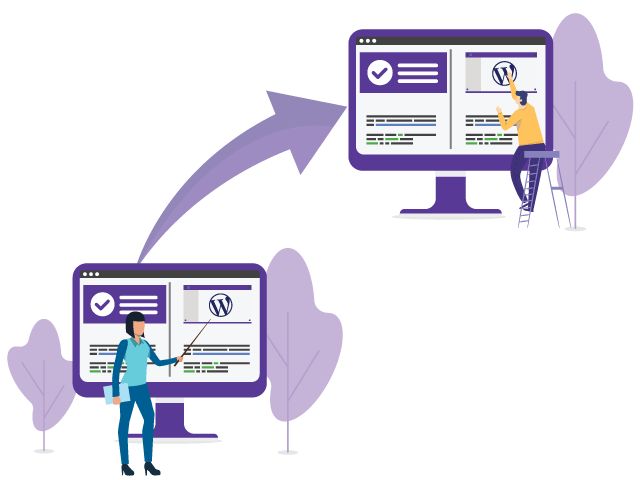Your Post-Migration SEO & Speed Optimization Checklist
Website migration, whether it’s moving from one server to another, changing hosting providers, or upgrading from shared to cloud hosting, is a critical technical event. While moving your website is just the first step, what comes next is just as important.

Without proper post-migration steps, your website might suffer from:
- Broken SEO rankings
- Slow page load times
- Indexing delays
- Security misconfigurations
At Nest Nepal, we not only ensure zero-downtime migrations but also support clients with a structured post-migration checklist to preserve performance, maintain SEO value, and ensure optimal functionality.
Here’s your complete Post-Migration SEO & Speed Optimization Checklist, designed especially for business owners and technical managers.
Why it matters:
Once your domain points to the new server, it can take anywhere from a few minutes to 48 hours for the DNS to propagate fully across the globe.
What to do:
- Use tools like dnschecker.org to confirm DNS A-records and NS updates.
- Ensure your domain now correctly points to the new hosting server (e.g., Nest Nepal’s IPs).
- Check from different locations and devices to spot propagation delays.
Nest Nepal tip:
We pre-reduce TTL (Time to Live) values before migration to speed up propagation. We also monitor DNS zones and guide you if any record needs adjustment.
2. Update Google Search Console & Submit New Sitemap
Why it matters:
Search engines may still crawl your old server, especially if IPs have changed or if URL structures were altered.
What to do:
- Log in to Google Search Console (GSC).
- Re-verify domain ownership if DNS has changed.
- Submit an updated sitemap (sitemap.xml) to prompt re-crawling.
- Monitor Index Coverage and URL Inspection reports for errors.
Nest Nepal tip:
If you’re using GSC with your business email, we help reverify and resubmit your sitemap automatically after DNS changes.
3. Check Robots.txt & Canonical URLs
Why it matters:
Sometimes during server moves, a restrictive robots.txt file may be enabled by default or canonical URLs may still point to the old domain.
What to do:
- Visit yourdomain.com/robots.txt and ensure it’s not blocking search engines (Disallow: /).
- Inspect canonical tags in your site’s header. They should reflect the current domain version (with or without www, http vs https).
Nest Nepal tip:
Our migration team checks these for you, especially for WordPress and Laravel migrations, and fixes any SEO-blocking misconfigurations.
4. Purge & Rebuild All Caches
Why it matters:
Old server-side caches or CDN caches can still serve outdated files, creating layout glitches or 404 errors.
What to do:
- Clear website caches (especially if using plugins like W3 Total Cache or LiteSpeed Cache).
- Purge your CDN (e.g., Cloudflare) cache manually.
- Clear browser cache if necessary during testing.
- Restart PHP OPCache if using a custom stack.
Nest Nepal tip:
If you’re on our NVMe cloud plans, our support team clears LiteSpeed Cache and server-level caching automatically post-migration.
5. Verify HTTPS and Renew SSL Certificates
Why it matters:
SSL certs don’t transfer automatically across servers. Insecure pages after migration can hurt trust and SEO.
What to do:
- Confirm that SSL is active on the new server.
- Reissue or renew the SSL certificate.
- Use a tool like WhyNoPadlock to detect mixed content errors.
Nest Nepal tip:
We auto-install and renew Let’s Encrypt SSL after migration for all domains hosted on our platform. We also ensure all HTTP requests redirect to HTTPS.
6. Test Site Speed with New Hosting Stack
Why it matters:
Moving to better hosting (like NVMe cloud from shared hosting) should improve speed, but only if optimization is in place.
What to do:
- Test your site using PageSpeed Insights and GTmetrix.
- Check Time to First Byte (TTFB), Largest Contentful Paint (LCP), and fully loaded time.
- Compare results before and after migration.
Nest Nepal tip:
Our NVMe-powered stack, combined with PHP OPCache and Brotli compression, can significantly improve your scores. Ask for our free optimization review post-migration.
7. Monitor Error Logs and Uptime
Why it matters:
The first 24 to 48 hours after migration are crucial. Misconfigurations, plugin issues, or broken links may surface during this period.
What to do:
- Monitor cPanel → Metrics → Errors or Logs section.
- Set up UptimeRobot or Jetpack Monitor for alerts.
- Use Google Analytics or Matomo to check for sudden traffic drops.
Nest Nepal tip:
We monitor server-level logs for you. If you notice unusual error logs or traffic patterns, just ping our support, and we’ll dive deep.
8. Ensure Email Functionality Post-Migration
Why it matters:
If your domain’s MX records or email routing weren’t updated correctly, you might miss important business emails.
What to do:
- Test sending/receiving from all email accounts.
- Reconfigure email clients (e.g., Outlook or mobile apps) if IPs or SSL settings changed.
- Check SPF, DKIM, and DMARC records to avoid spam issues.
Nest Nepal tip:
We check all email routing settings and replicate your webmail or business mail configuration, ensuring a smooth continuation of communication.
9. Confirm All Third-Party Integrations
Why it matters:
Payment gateways, CRMs, and analytics tools often rely on webhook URLs or IP whitelisting. A migration might silently break them.
What to do:
- Test contact forms, payment flows, and lead capture tools.
- Reconnect Google Analytics, Facebook Pixel, Zoho CRM, etc.
- Check any APIs or server IP whitelists (especially for payment providers like Khalti or eSewa).
Nest Nepal tip:
Let us know what tools you use, and we’ll check webhook paths and configure new IPs where required.
10. Communicate With Your Users (If Needed)
Why it matters:
If the migration affects login sessions, payment systems, or dashboards, letting users know helps maintain trust.
What to do:
- Send an email or post a banner saying: “We’ve upgraded our infrastructure for better speed and reliability.”
- Reassure customers that data and services remain secure and uninterrupted.
Nest Nepal tip:
We provide clients with sample copies and notifications for transparency during large migrations, especially for platforms serving end-users.
Final Thoughts: Smooth Migrations Go Beyond Just Moving Files

A website migration is successful not when the files are moved, but when performance improves, SEO is intact, and users never notice a glitch. Nest Nepal handles all backend tasks with precision, but post-migration steps like cache purging, Search Console updates, and DNS monitoring are where the real finesse lies.
For business owners and IT managers, this checklist helps you stay proactive and confident in the days following a website move.
Need help with a current or upcoming migration?
Talk to our migration team, we’ll handle everything from server provisioning to SEO and speed validation, so you can focus on what matters: running your business.